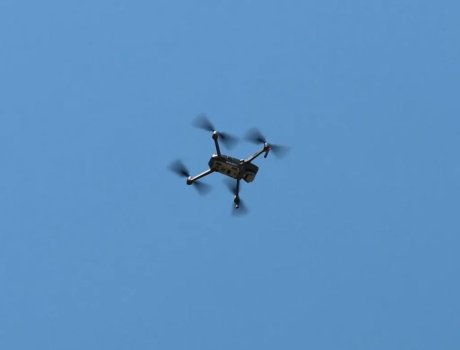Hernando County First Responders Utilize Modern Technology in their Work
Not many people know that drones have been around since the early 1900s. Most people associate them with realistic action films or “way out there” science fiction sagas, such as “Captain Phillips,” “Eye in the Sky,” “Blade Runner 2049” and “Chappie.” Once the stuff of fiction, now drones are used for recreational purposes, business activities and military operations. The use that most closely relates to the safety of the general public is that of our first responders.
The Hernando County Sheriff’s Office (HCSO) and the Hernando County Fire and Emergency Services (HCFES) utilize drones in many of their operations. The HCSO has had a drone unit since November of 2019. The HCFES has had their unit operational since October of last year. These two agencies have worked together on several operations and are planning on doing joint training this summer.
Corporal Mike Woodward, a 10-year veteran of the sheriff’s office, was the one who proposed the idea of a drone unit to Sheriff Nienhuis. Currently they have seven deputies who are certified drone pilots. They have to take the FAA Part 107 course and then pass a test in order to be certified. The test is almost equivalent to a basic knowledge test for a fixed-wing pilot. The members of the drone unit all have other duties. Some are traffic deputies, others are detectives, while others are patrol deputies, etc. The drones are useful in many situations. For example, they have been used to find missing persons, suspects fleeing and to assist fire rescue and forestry in locating brush fires, as well as determining the size and direction of the fire.
“Drones bridge the gap between the time a call comes in and the time the Aviation Unit can get on scene. They’re kept in agency vehicles so that they are readily available,” remarked Cpl. Woodward. Sometimes a helicopter isn’t even needed, so it saves quite a bit of money for the agency. Whereas a helicopter burns gallons of fuel in a short period of time, the only cost with the drones is charging or replacing the batteries when needed, and sometimes the propellers. In most cases, drones can often get to the scene faster than a helicopter can.
There are 13 drones in use at the present time. Four are smaller drones that can be used inside a structure or a confined area. Five of the drones have spotlights, speakers and infrared capabilities, which allow them to fly at night.
During the day, one deputy can work on a drone operation alone, but at night two deputies are required. One is the pilot and the other, a visual observer, who keeps an eye on the drone at all times. All the deputies in the agency are trained as visual observers. Pilots must obey all the FAA rules and are not allowed to fly higher than 400 feet. All drones must also be kept in visual line of sight.
Continue reading: https://www.hernandosun.com/2022/06/23/drones-first-responders/
Not many people know that drones have been around since the early 1900s. Most people associate them with realistic action films or “way out there” science fiction sagas, such as “Captain Phillips,” “Eye in the Sky,” “Blade Runner 2049” and “Chappie.” Once the stuff of fiction, now drones are used for recreational purposes, business activities and military operations. The use that most closely relates to the safety of the general public is that of our first responders.
The Hernando County Sheriff’s Office (HCSO) and the Hernando County Fire and Emergency Services (HCFES) utilize drones in many of their operations. The HCSO has had a drone unit since November of 2019. The HCFES has had their unit operational since October of last year. These two agencies have worked together on several operations and are planning on doing joint training this summer.
Corporal Mike Woodward, a 10-year veteran of the sheriff’s office, was the one who proposed the idea of a drone unit to Sheriff Nienhuis. Currently they have seven deputies who are certified drone pilots. They have to take the FAA Part 107 course and then pass a test in order to be certified. The test is almost equivalent to a basic knowledge test for a fixed-wing pilot. The members of the drone unit all have other duties. Some are traffic deputies, others are detectives, while others are patrol deputies, etc. The drones are useful in many situations. For example, they have been used to find missing persons, suspects fleeing and to assist fire rescue and forestry in locating brush fires, as well as determining the size and direction of the fire.
“Drones bridge the gap between the time a call comes in and the time the Aviation Unit can get on scene. They’re kept in agency vehicles so that they are readily available,” remarked Cpl. Woodward. Sometimes a helicopter isn’t even needed, so it saves quite a bit of money for the agency. Whereas a helicopter burns gallons of fuel in a short period of time, the only cost with the drones is charging or replacing the batteries when needed, and sometimes the propellers. In most cases, drones can often get to the scene faster than a helicopter can.
There are 13 drones in use at the present time. Four are smaller drones that can be used inside a structure or a confined area. Five of the drones have spotlights, speakers and infrared capabilities, which allow them to fly at night.
During the day, one deputy can work on a drone operation alone, but at night two deputies are required. One is the pilot and the other, a visual observer, who keeps an eye on the drone at all times. All the deputies in the agency are trained as visual observers. Pilots must obey all the FAA rules and are not allowed to fly higher than 400 feet. All drones must also be kept in visual line of sight.
Continue reading: https://www.hernandosun.com/2022/06/23/drones-first-responders/

